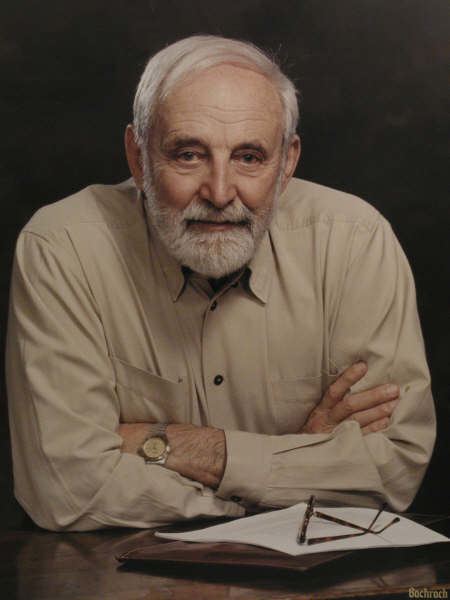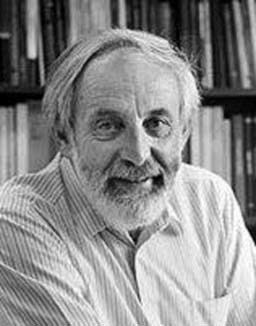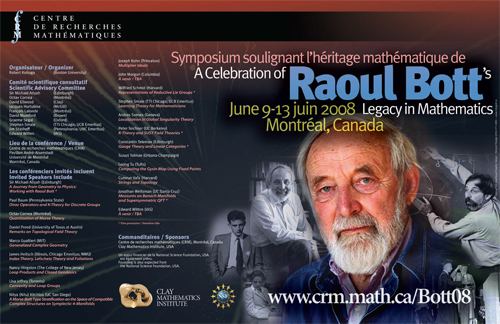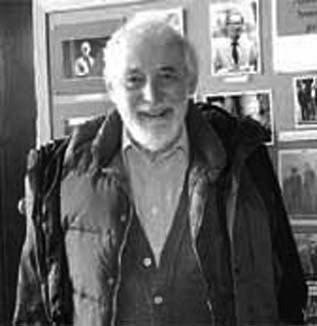Nationality Hungarian American Role Mathematician Name Raoul Bott | ||
 | ||
Born September 24, 1923Budapest, Hungary ( 1923-09-24 ) Alma mater McGill UniversityCarnegie Mellon University Doctoral students Edward B. CurtisHarold EdwardsRobert MacPhersonDaniel QuillenStephen SmaleAndras Szenes Books Graduate Texts in Mathematics Similar People | ||
What morse missed by not talking to weyl raoul bott
Raoul Bott, (September 24, 1923 – December 20, 2005) was a Hungarian-American mathematician known for numerous basic contributions to geometry in its broad sense. He is best known for his Bott periodicity theorem, the Morse–Bott functions which he used in this context, and the Borel–Bott–Weil theorem.
Contents
- What morse missed by not talking to weyl raoul bott
- Early life
- Career
- Awards
- Students
- Publications
- References

Early life

Bott was born in Budapest, Hungary, the son of Margit Kovács and Rudolph Bott. His father was of Austrian descent, and his mother was of Hungarian Jewish descent; Bott was raised a Catholic by his mother and stepfather. Bott grew up in Czechoslovakia and spent his working life in the United States. His family emigrated to Canada in 1938, and subsequently he served in the Canadian Army in Europe during World War II.
Career

Bott later went to college at McGill University in Montreal, where he studied electrical engineering. He then earned a Ph.D. in mathematics from Carnegie Mellon University in Pittsburgh in 1949. His thesis, titled Electrical Network Theory, was written under the direction of Richard Duffin. Afterward, he began teaching at the University of Michigan in Ann Arbor. Bott continued his study at the Institute for Advanced Study in Princeton. He was a professor at Harvard University from 1959 to 1999. In 2005 Bott died of cancer in San Diego.

With Richard Duffin at Carnegie Mellon, Bott studied existence of electronic filters corresponding to given positive-real functions . In 1949 they proved a fundamental theorem of filter synthesis. Duffin and Bott extended earlier work by Otto Brune that requisite functions of complex frequency s could be realized by a passive network of inductors and capacitors. The proof, relying on induction on the sum of the degrees of the polynomials in the numerator and denominator of the rational function, was published in Journal of Applied Physics, volume 20, page 816. In his 2000 interview with Allyn Jackson of the American Mathematical Society, he explained that he sees "networks as discrete versions of harmonic theory", so his experience with network synthesis and electronic filter topology introduced him to algebraic topology.
Bott met Arnold S. Shapiro at the IAS and they worked together. He studied the homotopy theory of Lie groups, using methods from Morse theory, leading to the Bott periodicity theorem (1957). In the course of this work, he introduced Morse–Bott functions, an important generalization of Morse functions.
This led to his role as collaborator over many years with Michael Atiyah, initially via the part played by periodicity in K-theory. Bott made important contributions towards the index theorem, especially in formulating related fixed-point theorems, in particular the so-called 'Woods Hole fixed-point theorem', a combination of the Riemann–Roch theorem and Lefschetz fixed-point theorem (it is named after Woods Hole, Massachusetts, the site of a conference at which collective discussion formulated it). The major Atiyah–Bott papers on what is now the Atiyah–Bott fixed-point theorem were written in the years up to 1968; they collaborated further in recovering in contemporary language Ivan Petrovsky on Petrovsky lacunas of hyperbolic partial differential equations, prompted by Lars Gårding. In the 1980s, Atiyah and Bott investigated gauge theory, using the Yang–Mills equations on a Riemann surface to obtain topological information about the moduli spaces of stable bundles on Riemann surfaces.
He is also well known in connection with the Borel–Bott–Weil theorem on representation theory of Lie groups via holomorphic sheaves and their cohomology groups; and for work on foliations.
He introduced Bott–Samelson varieties and the Bott residue formula for complex manifolds and the Bott cannibalistic class.
Awards
In 1964, he was awarded the Oswald Veblen Prize in Geometry by the American Mathematical Society. In 1983, he was awarded the Jeffery–Williams Prize by the Canadian Mathematical Society. In 1987, he was awarded the National Medal of Science.
In 2000, he received the Wolf Prize. In 2005, he was elected an Overseas Fellow of the Royal Society of London.
Students
Bott had 35 Ph.D. students, including Stephen Smale, Lawrence Conlon, Daniel Quillen, Peter Landweber, Robert MacPherson, Robert W. Brooks, Robin Forman, András Szenes, and Kevin Corlette.
